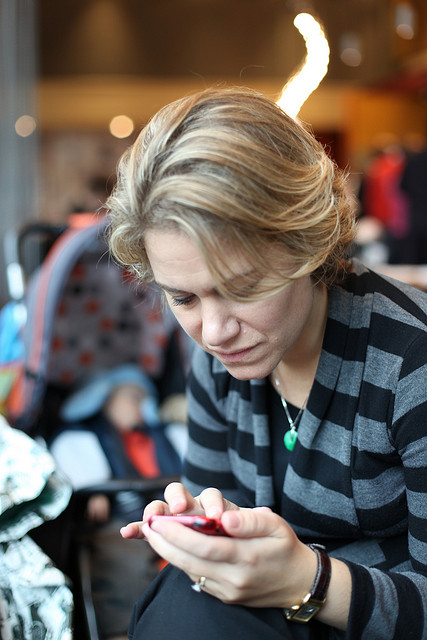Cellphones are inappropriate in many places. Sign from Smart Sign.
In 1996 Sherry Turkle, professor of the Social Study of Science and Technology at MIT, made a name for herself speculating about the potential of virtual communities to enrich our actual lives. By 2013, she had pulled a 180 and was sounding out warnings on how smartphone dependency erodes our ability to connect with people, depriving us of the richness of a full human experience.
People seek connections with others. It’s a millennia-old compulsion that we get a taste of every time we get a new follower on Twitter, or when the orange and white heart pops up on Instagram telling us that someone likes one of our pictures.
Conversations are how we come to understand ourselves and others. Through conversation, we exchange ideas and explore personal thoughts. And every time we send a text or get a Facebook comment, it’s like getting a little droplet of conversation.
But not all connection is created equal, and what we get from technology is a poor approximation of the real thing. The undercurrents of empathy and emotion are lost or diluted in these technologically metered interactions.
According to Turkle, not only are these piecemeal interactions of a lower quality than an actual conversation, but keeping up with electronic socializing, our dazed faces pointed at tiny screens, is fracturing the face-to-face interactions that we do have. We can’t devote our full attention to the conversations we’re having, including all the boring, unflattering and unedited bits that rarely make it through the sieve of technology.
Addictive cell phone use.
Turkle argues that our addictions to the easy, tightly-controlled interactions we have over our cellphones are like the junk food of human connection and that they rob interactions of value and atrophy our ability to form attachments to others.
Even before an MIT professor spent years studying the phenomenon and writing a book about it, most of us have found this to be intuitively true. It’s irritating to launch into a story, only to have the person you’re talking to break the rhythm by picking up their phone to quickly check an email. A gaggle of teenagers with their faces glued to their phones seems just as bad an image as if they were zoned out in front of the TV, their mouths hanging slightly open.
Most of us have also succumbed to the strong psychological pull of smartphones. It has become common practice for people to sleep next to their cellphones and check them the instant they wake up. Who among us hasn’t dispelled an awkward moment alone by pulling out a cellphone? For every time a friend has annoyed us with their cellphone addiction, each of us has surely done the same.
In addition to spelling out the problem, Turkle implores people to start thinking about what all this technology is costing us. Our ability to form strong attachments to machines is relatively new. Smartphones didn’t exist in this way ten years ago, and Turkle is unsettled by recent advancements in the human-machine relationship.
Turkle’s greatest fears concerning the human ability to empathize with robots are illustrated in a study she conducted at a nursing home. An old woman whose child had recently died talked to a robot in the shape of a baby seal and programmed to react to the woman with dewy eyes and sympathetic nods. The old woman was comforted. To some this was the sign of a great technological advancement; a machine had succeeded in mimicking emotion. To Turkle, however, it was saddening. This woman was clearly in need, and while she sought comfort in a metal seal who knew nothing of life, death or love, somewhere out there was an actual human, staring into a cellphone, opting instead to give and seek connection with a glass screen.
“Gallant Conversation,” a painting, c. 1663 by Quirijn Gerritsz van Brekelenkam, depicting the now endangered art of conversation. From the Metropolitan Museum of Art.
